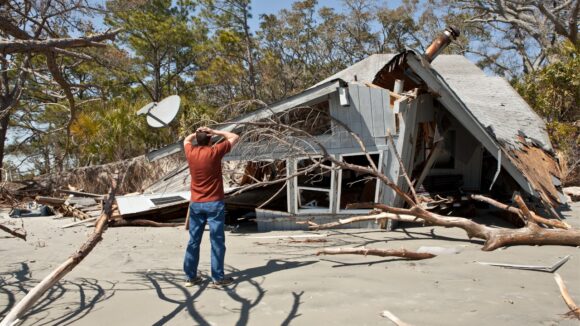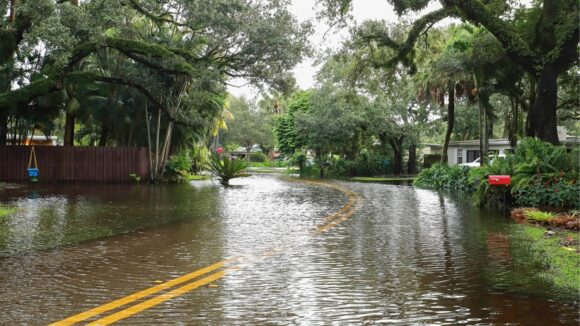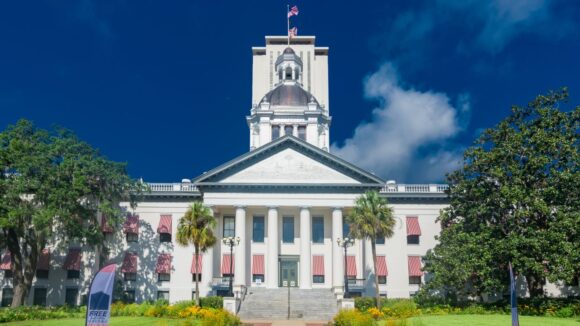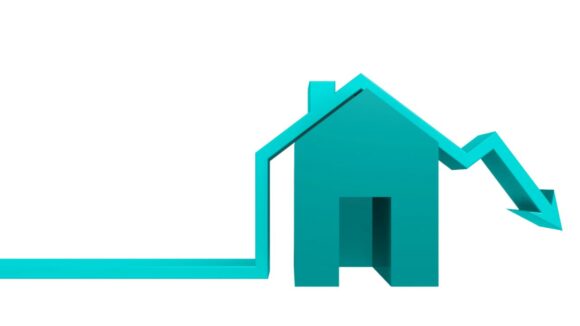This post is part of a series sponsored by AgentSync.
Florida’s struggles to retain a property and casualty (P&C) insurance market have made headlines and spurred a special legislative session this year. With a package of regulatory overhauls and an unprecedented move for state-backed reinsurance, it remains to be seen whether the reforms can plug the holes of Florida’s beleaguered system.

General struggles in P&C across the country
As climate change increases the number and severity of natural disasters and their accompanying damages, states particularly vulnerable to drought or floods have struggled to maintain coverage options for homeowners.
California has stop-gap measures enabling the insurance commissioner to put a moratorium on home insurance cancellations in disaster areas. In the wake of Hurricane Katrina, the biggest insurers pulled out of homeowners insurance in Louisiana. That state now maintains its P&C market through smaller, more localized insurers, which the state tailors its regulatory culture to, as evidenced by this year’s legislative packages.
Overall, a McKinsey report echoes the anecdotal evidence of these states: P&C insurance has in recent years left larger incidents uninsured, and tends to perform better for smaller carriers interested in localized coverage and underwriting. Unfortunately, there’s still no widespread solution that delivers that coverage at a more affordable rate for consumers. Fewer insureds often means more expensive coverage for those who do retain it.
Broadly speaking, then, Florida is hardly alone in needing to address a property insurance market that has as many challenges as it does opportunities. Yet, in a season that’s seen relatively few disastrous incidents thus far, why are so many insurance companies leaving Florida?
Why is homeowners insurance so expensive in Florida?
There’s no single reason homeowners insurance has ballooned – although it’s true that the typical Florida homeowners insurance premium is three times the national average. Instead, there are a few reasons. For one thing, insurers’ underwriting and premium assessments haven’t kept up with rising risk, which has eaten into surpluses and caused losses in profitability. However, a few factors unique to Florida have created a snowball effect that goes well beyond the market adjustments we see in other coastal states (more on how these create a perfect storm for carriers later on):
- Roof coverage and replacement rules: Florida law requires homeowners to replace roofs that have sustained 25 percent or more in damage. However, carriers may require homeowners to meet a deductible for coverage, or may reject a roof claim outright.
- Assignment of benefits: An assignment of benefits, or AOB, allows a homeowner to sign their policy benefits over to a roofing company so the roofer can directly approach an insurance carrier about the cost and reimbursement of roofing repairs, or enlist a public adjuster to back up their assessment of damage.
- Attorney fee multiplier: A court case in 2017 affirmed and strengthened a legal principle in Florida that an attorney can collect as much as 250 percent of a typical attorney fee if they win a lawsuit on behalf of a homeowner. The rule is based on the understanding that these are typically “contingency cases,” meaning attorneys only get paid if they win. So, homeowners’ suits can be unattractive when compared to other cases where your firm is guaranteed compensation for their billable hours. The idea of the fee multiplier was to encourage attorneys to take on cases on behalf of homeowners.

For an anecdotal perspective on how these factors have played out in recent years, several media outlets have profiled homeowners whose stories have a similar thread:
A Florida property owner is approached by a roofing contractor who asserts that the property’s roof has substantial enough damage to warrant a total replacement. The contractor assures the homeowner that the damage will be fully covered by their insurance; in fact, if the homeowner will just sign an AOB, the contractor and their legal team can even handle the insurance end of the roof replacement for them, no hassle!
The Florida property owner signs the AOB, and then has to wait for months, or years, while the roofing contractor engages an insurance carrier. The carrier may dispute that the roof has damage equaling or exceeding 25 percent of its value. The roofing contractor then sues the carrier for the benefits, leading to months of protracted litigation, and often resulting in coverage for a brand new roof as well as tens of thousands of dollars in attorneys fees, incentivized by those 100 to 250 percent multipliers.
If the carrier wins, it still has to pay its attorneys’ fees.
Taken together, these rules have yielded a crisis for the Florida homeowners insurance industry. Consider: Florida has largely avoided a major hurricane season since 2018. Florida homeowners compose 9 percent of annual claims in the U.S. However, Florida accounts for 79 percent of annual homeowners claims lawsuits.
The downstream result is premiums that have risen in triplicate for some property owners, and insurers have become increasingly unwilling to take the risk of insuring roofs over the age of 10 years old.

Florida P&C market in crisis as insurers leave, ratings downgraded
The Florida homeowners insurance crisis reached a fever pitch in the last year as insurers have backed out of the state entirely.
In a proclamation calling for a special session of the legislature in late May 2022, Gov. Ron DeSantis justified the emergency measure with stats such as, “the Florida insurance industry has seen two straight years of net underwriting losses exceeding $1 billion each year,” and “Citizens Property Insurance, the State of Florida’s public insurer of last resort, has seen an increase of 399,822 policies since the beginning of 2020 and is on track to be over 1 million policies by year end.”
So, very clearly, the market is losing money, and more people are being forced onto the state-backed insurer after their insurers leave the market.
And, to be clear, insurers are certainly leaving the market.
In July 2022, Bankers Insurance Group became the thirteenth insurance company to begin liquidating or stop offering new policies just this year. For perspective, the Tampa Bay Times noted there were 63 P&C insurers required to report financials in the state as of the end of 2020 (a list that included companies in the process of liquidation even then). That same year, the Times said, an analysis of the market showed only four companies had demonstrated profitability at all.
And, lest you think condominium owners in Florida have it better… After a tragic building collapse that killed 98 people in Surfside, Florida, in 2021, a $1 billion insurance settlement has driven P&C carriers away from insuring Florida condos. For carriers that choose to remain in the Florida condo market, there’s so little competition that prices can double, triple, or more and consumers have no option to shop elsewhere.
Florida’s special session P&C insurance legislation
With the available pool of insurers facing contractions of more than 10 percent, DeSantis and the legislature went back to the table after the regular session to address some of the underlying factors that have driven market collapse in the last five years.

May 24, 2022, the legislature passed sweeping legislation aimed at reforming the market, with the Florida governor signing it into law two days later.
Provisions of the law include:
- $2 billion allocated to a Reinsurance to Assist Policy program, giving insurance companies assistance to place reinsurance contracts for coverage
- $150 million in grants to Florida homeowners for “home hardening,” aiming to make homes more resilient to storm damage
- Requirements that carriers cover roofs less than 15 years old, or roofs that “have at least five years of useful life remaining”
- New standards for attorney fee multipliers and attorney’s fee assignments, “disincentivizing frivolous claims”
Some lawmakers in Florida sought to bar policyholders from contesting claims denials in court altogether, while others defended claims suits, saying they’re an important enforcement mechanism that incentivize carriers to pay claims in the first place.
Other criticisms argued that the laws don’t go far enough to protect consumers, who will likely not see reduced or even plateauing premium costs for years after the law’s implementation. One property insurance law group criticized the law as one-sided, admitting policyholder and contractor fraud has played a role, but saying:
“The ‘F’ word is not a one-way street… Contrary to popular belief, insurance companies continue to avoid their contractual and statutory obligations despite their incessant concerns about defending ‘rampant’ lawsuits. Actually addressing the truly frivolous litigation is step one in beginning to solve our property insurance market issue, but why stop there? … The same efforts need to be targeted at combating the unspoken immunity that is insurer fraud…”
Demotech homeowners P&C insurance rating downgrade
While Florida legislators hope the new law will forestall more P&C market turbulence, there are still choppy waters ahead.

For one thing, Florida insurance carriers rely heavily on Demotech, a ratings agency, to provide judgments about solvency for the carriers in the state. In July, Demotech’s plans to downgrade the ratings of 17 P&C carriers brought swift furor from the Florida Association of Insurance Agents (FAIA) and state regulators. By downgrading these carriers, Demotech would be signaling to consumers that these carriers aren’t adequately pricing and underwriting their contracts, and warns of placing contracts with them.
A downgrade could also have secondary repercussions, as many mortgage backers require homeowners to hold insurance policies with companies that meet certain solvency standards.
The FAIA and state regulators didn’t name which carriers Demotech planned to downgrade, but seven were made public in the beginning of August.
With the number of active P&C carriers willing to provide new homeowner policies in the state hovering under 50, at this point, having 17 downgraded could be devastating to the overall sustainability of the market.
In an effort to keep the market afloat, the Florida Office of Insurance Regulation (OIR) took a truly unprecedented step, offering temporary reinsurance contracts with the full backing of the state’s insurance company, Citizens Property Insurance, and, further, the state’s guaranty association. A news release from Commissioner David Altmaier’s office said the arrangement should satisfy requirements for mortgages backed by Fannie Mae and Freddie Mac.
Future of Florida homeowners insurance market remains uncertain
The Florida OIR and legislature are clearly making efforts to shore up the market, harden homes, and retain a profitable environment safe for consumers. Yet, just as these extreme conditions didn’t arise overnight, real solutions will take time.
It remains to be seen how effective this year’s actions will be, as well as what the legislature may propose in next year’s session to further bolster the Florida P&C market. In the meantime we will hope for Florida to see clear skies, smooth water, and sunshine.
At AgentSync, there’s little we can do to directly affect P&C claims and Florida market conditions. However, for carriers, MGAs, and agencies, we can help streamline producer and adjuster licensing, verification, and appointments. For more on how, check out our solutions.
Topics
Trends
Florida
Market
Homeowners